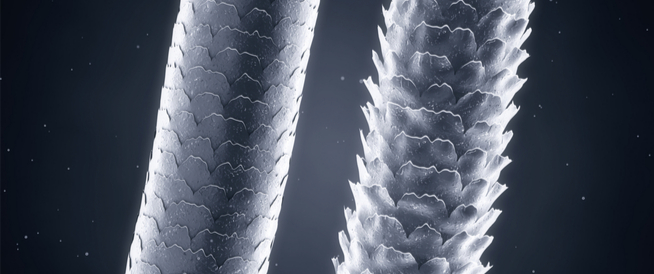What is hair porosity? And should you take care of your hair differently based on its porosity? Important information and details will be discussed in this article.

Have you ever heard of hair porosity? What does it mean for the health of your hair specifically? Answers and more are coming up:
What is Hair Porosity?
Hair porosity is a term that refers to the ability of a hair strand to absorb and retain moisture.
Hair porosity has several different levels, and you may need to follow a special hair care routine based on your hair's porosity level.
To understand hair porosity better, let's look at the layers that make up a hair strand, which are:
- Cuticle: The outer layer that surrounds the hair and protects its inner layers, consisting of small, tightly packed scales resembling roof tiles.
- Cortex: The thickest layer of the hair, containing the natural pigment and protein fibers.
- Medulla: The soft, central part of the hair.
Hair porosity specifically relates to the outer layer of the hair, the cuticle. The hair's ability to absorb and retain moisture depends on how tightly the scales of the cuticle are packed together.
Causes of Hair Porosity
The level of hair porosity is influenced by factors that are typically classified into two main categories:
- Genetic and hereditary factors, such as: ethnicity, hair growth rate, and hereditary diseases.
- External factors, such as: combing methods, treatments the hair is exposed to, and the type of shampoo and its usage.
Hair Porosity Levels
Here are the levels of hair porosity:
1. Low Porosity Hair
Low porosity hair has tightly packed cuticle scales, making it difficult for moisture to penetrate the hair shaft. However, once the moisture is absorbed, it doesn't easily escape, meaning the hair doesn't dry quickly after showering.
Due to the slow rate at which moisture penetrates the hair, hair care products and oils tend to accumulate on the scalp over time.
Here are the recommended care tips for low porosity hair:
- Regularly trim the ends, as they tend to become brittle and dry quickly.
- Use steam or wrap the hair in a warm, damp towel or apply warm oils, as the heat helps the cuticle scales separate slightly, allowing moisture absorption.
- Focus on using oils such as coconut oil, jojoba oil, and argan oil.
- Additional tips: Use a clarifying shampoo once a week, apply moisturizing masks containing banana or avocado bi-weekly, and use moderate amounts of hair care products.
2. Normal Porosity Hair
Normal porosity hair has moderately packed cuticle scales, which allows it to absorb and retain enough moisture.
Due to this balanced porosity, the hair appears healthy, shiny, and thick.
Normal porosity hair does not require special care and is easy to style and maintain.
Here are the recommended care tips for normal porosity hair:
- Avoid excessive heat styling and exposure to harmful chemicals like hair dyes.
- Avoid overusing hair products and products containing silicone made from oily or greasy materials.
3. High Porosity Hair
High porosity hair has widely spaced cuticle scales, allowing it to absorb moisture quickly but lose it just as fast.
As a result, this hair tends to be dry, weak, and brittle, and is more prone to tangling than other types.
Here are the recommended care tips for high porosity hair:
- Avoid excessive washing, combing, and styling, and use appropriate products regularly to protect and seal the hair.
- Use masks and oils before washing, which can help the hair absorb them better, or use leave-in conditioner every other day.
- Dry hair at low temperatures or let it air dry naturally in room temperature.
- Focus on using oils like coconut oil, jojoba oil, avocado oil, and olive oil.
- Wash hair with cold water during showers.
Hair Porosity Test
Would you like to know your hair's porosity level? Try one of these methods:
1. Fragrance Test
Visit a place with strong fragrances and stay for at least half an hour. Here's what to expect:
- If your hair smells like the place you visited, it is high porosity.
- If your hair doesn't change smell, it is low porosity.
- If your hair picks up a slight fragrance, it is moderate porosity.
2. Float Test
To perform this test, take one or more dry hairs and drop them into a cup of lukewarm water. Watch the hair for a few minutes. Here's what to expect:
- If the hair sinks quickly to the bottom, it is high porosity.
- If the hair sinks slowly, it is moderate porosity.
- If the hair floats on the surface or settles slightly below, it is low porosity.






